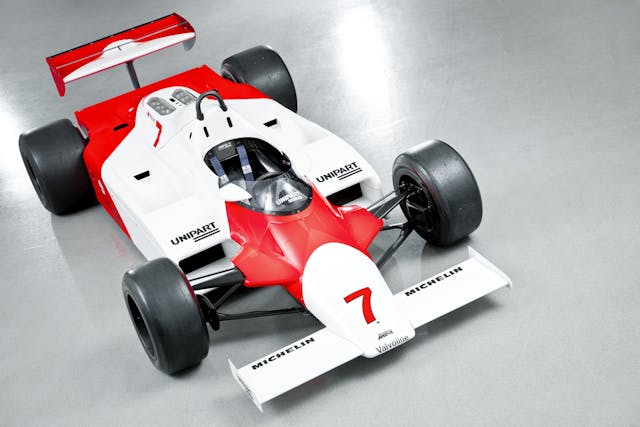Never Stop Driving #87: Will Your Future Uber Be a Flying Car?
As so often happens, my eyes were opened while I shared a brew with a friend at a local bar. A man sitting nearby overhead our conversation which was, of course, about cars, and volunteered that he worked for the composites company Hexcel.
You’ve probably never heard of Hexcel, but my friend and I, both longtime motorsports fans, had, so the Hexcel man didn’t need to explain further. Hexcel owns Hercules, the Utah company that built the 1981 McLaren MP4/1, a milestone Formula 1 racer. Designed by legendary British racing engineer John Barnard, it was the first to use light and strong carbon fiber, rather than metal, for its structure, a recipe every F1 and Indy car would later follow. Most of today’s hypercars also use carbon-fiber tubs. The MP4/1 evolved into the MP4/4, designed by American Steve Nichols, that won fifteen of sixteen 1988 F1 races.

During our impromptu nerd fest, the Hexcel employee volunteered that his company was consulting with firms designing so-called vertical takeoff and landing (VTOL) aircraft. These crossbreed machines can take off like a helicopter but then fly efficiently like a plane. Electric versions, called eVTOLs, promise to operate with much less noise. My buddy, an accomplished race-car engineer, driver, and private pilot, knowingly nodded. “Yeah, there’s a lot going on in that space,” he said. As usual, I was clueless.
Since this column leans toward autonomous vehicle development, I had not kept up with another transportation revolution, the one that could happen in the air above us. I’d heard about VTOLs but I lumped them in with the flying-car fantasy that never seems to die. It turns out there’s a similar venture-funded gold rush to this nascent industry, which is often called “air taxis.” According to the consulting firm McKinsey, people around the globe spend $500 billion on taxi services, but that system is at capacity. Adding more car taxis at this point simply exacerbates the already extreme congestion. It’s time to go skyward.
The trick will be making this air travel cheap enough that VTOLs are not simply a replacement for the helicopters that already whisk the rich and famous above traffic. Billions of investment is pouring into the space, which suggests speculators see a larger market than just the well-heeled. Even some car companies, including Toyota, are jumping in, with half a dozen having invested in VTOL enterprises.
Perhaps air taxis will turn out to be a better investment than EVs, which went from being the next big thing to “who’s going to buy these?” in an astonishingly quick six-month period.
Of course, there are many challenges facing VTOLs, since aircraft are even more regulated than cars. A plan to debut flying taxis at this summer’s Paris Olympics is at serious risk due to regulatory approval holdups. We live in very interesting times.
In other news from Hagerty Media:
- Man steals truck loaded with eight new Corvettes
- I wish I had the dough for this GT40 that will be auctioned next week
- Henry Catchpole looks back at one of the best driver’s cars ever made, the Lotus Elise
Talk about a touchy subject: For this week’s podcast, I spoke with the founder and CEO of Sacrilege Motors, a company that converts vintage Porsche 911s to electric propulsion. I recommend an open mind. Listen on Apple, Spotify, and YouTube.
Thanks for reading! If you’d like to support us, please share our material and join the Hagerty Drivers Club.
Have a great weekend!
Larry
P.S.: Your feedback is very welcome. Comment below!
Please share this newsletter with your car-obsessed friends and encourage them to sign up for the free weekly email. The easy-to-complete form is here. And if you’d like to support the efforts of Hagerty Media, please consider joining the Hagerty Drivers Club.



Any time I see an article on flying cars, I think that most people can’t drive in 2 dimensions, much less 3. Also, there are a lot of hoopties on the road. If one of those breaks down, you coast to the side of the road. If your flying car breaks…yikes. Think of your friend who “knows his car” while the low fuel light gets brighter…
Yeah, interesting point. The stuff I’ve read is you have to have pilots fly the VOTLs
Dear God, please don’t let this happen until after you’ve taken me home…
Interesting comment about Hexcel. Now retired, my former company designed and built automated production systems for the Hexcel facility in Seguin, TX that made both carbon fiber and fiberglass “cloth” (in separate, controlled facilities to avoid contamination), as well as equipment and tooling for another company with huge autoclaves making carbon fiber components for the aerospace industry in Boerne, TX. I always wondered why, when Corvette was having problems with suppliers for their carbon fiber components on the C8 Corvettes, they never utilized these proven U.S. manufacturers from the aerospace industry. But, then again, those decisions are above my pay grade.
BTW, thanks for your articles. They are very much enjoyed.
Interesting career Jake. Thanks for sharing and reading.
1. Please deemphasize motor sports. Does Hagerty insure race cars?
2. I disagree with the promotion of autonomous driving. There will always be one more lesson for the system to learn. Will Hagerty insure the technology?
3. I am a paid-up member of Hagerty Drivers Club. Why do I not receive my issue of Hagerty Drivers Club magazine?
Sorry to hear about your issue with the Hagerty Drivers Club, the best way to get that resolved is by calling us at 800-922-4050.
I can’t imagine how this would ever work out. I can barely afford driving my land based car right now because of the cost of insurance. How much would insurance cost if I were to be liable for everything underneath the car too.
Thank you, Larry.
Always thought-provoking.
Love your stuff..
VTOL not always safe… US Osprey crash and some dicey history on its flight capabilities.
https://www.military.com/daily-news/2024/02/20/air-force-confirms-part-failure-occurred-deadly-japan-osprey-crash-left-8-airmen-dead.html
Helicopters and drones are already annoyingly noisy – thousands of flying cars are simply not going to sound like the Jetsons.
Let it go already.
They claim the electrically powered versions are far quieter. They’re definitely away of the noise issue.
Hey Larry, I am an old aerospace engineer specializing in composite structures dating back to when it all began in the very late ’60s.Your article bought back many memories of excited conversations with folks like Hexcel as we were developing the aircraft of the future. Being a car guy, you have inspired me to see the next steps in useful composites structures besides fishing poles. Stay curious friend.
Wow, you were on the ground floor for the composites. Super cool. Thanks for reading.
Larry:
Noted your reference to Hexcel. As a former leader of the GM Safety Test Lab, I was well aware of the light weight, precision engineering and flexibility of the Hexcel materials we used for energy absorbing structures we widely used in crash testing.
It’s no surprise to me that Hexcel is active in the air taxi space. I’ve seen stories from time to time as various companies test their products. But it occurs to me that air taxis and electric vehicles share a potential blind spot. It’s not the technology, which I’m sure can be solved. It’s the issues related to deployment and growth. For EVs it is the range and charging infrastructure. For air taxis it’s air space control and regulation.
As air taxis become closer to being a major revolution in transportation, hopefully someone in the FAA is seriously working on airspace management and control for the future when clouds of air taxis dominate our world.
Well Larry, I have no doubt that the technology for developing these new modes of transport is within reach and potentially heading for assembly line production. My concern as always is who will pilot them. What criteria will be mandated for those who wish to motivate one? As well all know painfully well, driving in one dimension has become more than a challenge for most on our roads, I can’t imagine, or maybe I can, what adding another will do. This mode almost demands some kind of automatic piloting feature. Otherwise, these things colliding in mid air and dropping onto who knows what would be a horrendous occurrence.